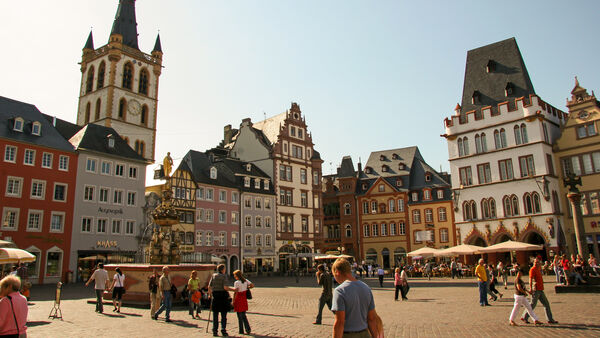Historic Trier on the Mosel River
By Rick Steves
Trier, Germany's oldest city, lies at the head of the scenic Mosel Valley near the Luxembourg border. An ancient Roman capital, Trier brags that it was inhabited for 1,300 years before the Romans arrived. Today Trier feels young and thriving. A short stop here offers you a look at Germany's oldest Christian church, one of its most enjoyable market squares, and its best Roman ruins.
Founded by Augustus in 15 BC, Trier was the Roman "Augusta Treverorum" for 500 years. For most of the fourth century, this city of 80,000 — with a four-mile-long wall, four great gates, and 47 round towers — was the favored residence of Roman emperors. Emperor Constantine used the town as the capital of his fading western Roman Empire.
Today Trier's Roman sights include baths, a 25,000-seat amphitheater, and a huge city gate. Of the original four gates, only the Porta Nigra survives. This most impressive Roman fortification in Germany was built without mortar — only iron pegs hold the sandstone blocks together.
While the other three gates were destroyed by medieval metal and stone scavengers, this "black gate" survived because it became a church. St. Simeon — a pious Greek recluse — lived inside the gate for seven years. After his death in 1035, the Simeon monastery was established and the gate was made into a two-story church — lay church on the bottom, monastery church on top. Napoleon had the church destroyed in 1803, but the 12th-century Romanesque apse survived. You can climb around inside the gate, but there's little to see other than a fine town view.
Trier's main pedestrian drag, which leads away from the gate, is named for St. Simeon. The arcaded courtyard and buildings of the monastery of St. Simeon remain, and are now home to the tourist information office and the slick City Museum (Stadtmuseum Simeonstift). The museum's collection seems to be largely made up of anything old that turned up in townspeople's basements, and most of the items on display are only mildly interesting. However, the third floor holds a fascinating model — painstakingly constructed over 19 years — of Trier as it looked in 1800.
Trier's market square is a people-filled swirl of fruit stands, flowers, painted facades, and fountains. This is one of Germany's most in-love-with-life marketplaces. Its centerpiece, a market cross from 958 (with an ancient Roman pedestal), celebrates the trading rights given to the town by King Otto the Great. The adjacent Renaissance fountain symbolizes thoughtful city government with allegorical statues of justice (sword and scale), fortitude (broken column), temperance (wine and water), and prudence (snake and mirror).
The city's cathedral, the oldest in Germany, goes back to Roman times. St. Helena, the mother of Emperor Constantine (who legalized Christianity in the Roman Empire), let part of her palace be used as the first church on this spot. In 326, to celebrate the 20th anniversary of his reign, Constantine began the construction of St. Peter's in Rome and this huge cathedral in Trier. The cathedral contains two important relics — the "Holy Robe" of Christ (found by St. Helena on a pilgrimage to Jerusalem) and a "holy nail" thought to be from the Crucifixion.
The city's basilica, at 200 feet long and 100 feet high, is the largest intact Roman structure outside of Rome. I like to imagine this hall of justice in ancient times: decorated with golden mosaics, rich marble, colorful stucco, and busts of Constantine and his family filling the niches. The emperor sat in majesty under a canopy on his altarlike throne.
Nearby is the town's archaeological museum, clearly Trier's top museum, with arguably the best collection of Roman art in Germany. The museum tells the town's story from prehistoric times to today. The best pieces are all from the Roman period, including funeral art, mosaics, coins, and a fine model of Roman Trier.
The museum's huge collection is due in part to the fact that Trier had been home to what was intended to becom the most intricate baths of the Roman world. Trier's cold northern climate, the size of the complex, and the enormity of Constantine's ego meant that these Imperial Baths required a two-story subterranean complex of pipes, furnaces, and slave galleys to keep the water at a perfect 47 degrees Celsius (120 degrees Fahrenheit). But the grandiose vision was never finished. When Constantine left Trier in AD 316, the huge and already costly project was scuttled. But 30 years of construction left nearly a mile of underground tunnels and foundation work, which are fun to explore.


